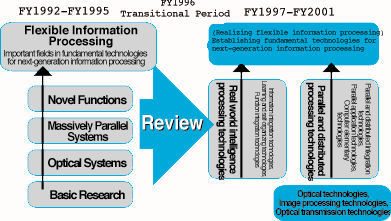
Toward Establishing Fundamental Technologies for Next-generation Information Processing
Electronics Policy Division,Machinery and Information Industries Bureau,
Ministry of International Trade and Industry

The RWC Project aims to establish a system of innovative computer technologies which can directly process information in the real world. After three years of investigations and studies, the 10-year RWC Project started in fiscal 1992 with the Real World Computing Partnership as its core.
Over the 5 years since that beginning many studies have been made on experimental themes. As a result, we have come to recognize a number of uncertainties regarding the integration of flexible information processing with its own platform, the original target of this project. The Ministry of International Trade and Industry (MITI) has reviewed this project for the next stage of the project from fiscal 1997 through discussions at both the evaluation and promotion committee and preparation committee in March, 1996.
The Project Plan from fiscal 1997 will soon be available for your discussion. Basic directions dictate the Project for Fundamental Information Technology of the Next Generation (title tentative), which would inherit the framework of the RWC Project and progressively reorganize it. The main feature of this Project is that individual research and development themes are not chosen solely from the perspective of their relations with flexible information processing, but that research and development will be carried out with the most appropriate schemes by setting up objectives and challenges in the key technology fields as a foundation for the next-generation information processing technologies and in important areas in each field of technology.
It is expected that a new synergy will be generated as the above areas are set up. The Project itself will be discussed in more detail below.

Currently there are two designated fields: I. fundamental technologies for parallel and distributed processing, and II. fundamental technologies for real world intelligence processing.
I. Fundamental Technologies for Parallel and Distributed Processing
To conduct research and development of parallel and distributed computing technologies, a computer architecture (basic structure) which enables instantaneous large-scale information processing by combining optical technologies and conventional electronic technologies.
[Main Technical Challenges]
(1) Parallel and Distributed Integration
Technologies (including
optical technologies)
A technology to build a group of computers seamlessly integrated with any extension and the performance equivalent to computers╣ internal bus (signal path). To implement a brand new massively parallel architecture in a flexible and easy manner, by linking computing resources inside computers (such as CPU, memory) with optical transmission technologies.
(2) Parallel Application Technologies
To develop programs required for accelerating information processing by optimizing computer systems and minimizing energy consumption. Developed programs will be applied to optimization and minimizing energy consumption of various information processing systems.
(3) Elementary Technologies for Next-generation Parallel Computers (including Optical Technologies)
Elementary technologies for building advanced computers such as optical computers and variable architectures. For the optical field, technologies for developing next-generation pattern information processing by building optoelectronic and computer architecture elements with optical technologies.
II. Fundamental Technologies for Real World Intelligent Processing
For computers, real world information is unordered and incomplete information and cannot be handled just by extending the existing information processing technologies. A system of information processing technologies that directly processes real world information and enables communication between man and machine on an equal level will be developed, that is, technologies for understanding and processing information by integrating information from various sources to complement individual information sources.
[Main Technical Challenges]
(1) Information Integration Technologies
Technologies for computers to recognize, understand, and judge information by processing ambiguous, incorrect, and incomplete information in the real world such as images and speeches in an integrated manner.
(2) Learning and Self-organizing Technologies
Technologies for systems to adapt to and evolve on their own by autonomously capturing information through interaction with the environment even in the ever-changing real-world environment.
(3) Function Integration Technologies
Technologies for integrating the function technologies stated in (1) and (2) above.

Ultimately speaking, the project is "researchers" and a "place" for "researchers" to communicate with one another. The main goal of the Project for Fundamental Information Technology of the Next Generation is to provide researchers with a wholly new "place". This "place" is being used to prepare for Japan's future, as well as to reflect the goals of companies and organizations to which the researchers belong. An approach to achieving dreams while making steady progress is important. "Next-generation" systems do not only literally belong to the next generation, but are a very realistic work of ours. We look forward to your continued support.